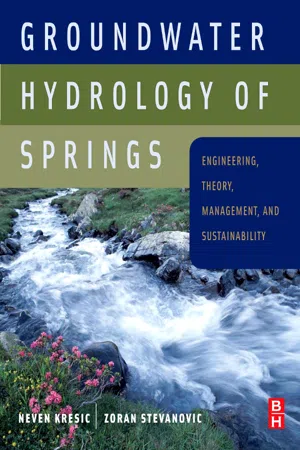
Groundwater Hydrology of Springs
Engineering, Theory, Management and Sustainability
- 592 pages
- English
- ePUB (mobile friendly)
- Available on iOS & Android
Groundwater Hydrology of Springs
Engineering, Theory, Management and Sustainability
About this book
Groundwater Hydrology of Water Resource Series - Water is an essential environmental resource and one that needs to be properly managed. As the world places more emphasis on sustainable water supplies, the demand for expertise in hydrology and water resources continues to increase. This series is intended for professional engineers, who seek a firm foundation in hydrology and an ability to apply this knowledge to solve problems in water resource management. Future books in the series are: Groudwater Hydrology of Springs (2009), Groudwater Hydrology of River Basins (2009), Groudwater Hydrology of Aquifers (2010), and Groudwater Hydrology of Wetlands (2010).First utilized as a primary source of drinking water in the ancient world, springs continue to supply many of the world's cities with water. In recent years their long-term sustainability is under pressure due to an increased demand from groundwater users. Edited by two world-renowned hydrologists, Groundwater Hydrology of Springs: Theory, Management, and Sustainability will provide civil and environmental engineers with a comprehensive reference for managing and sustaining the water quality of Springs. With contributions from experts from around the world, this book cover many of the world's largest springs, providing a unique global perspective on how engineers around the world are utilizing engineering principles for coping with problems such as: mismanagement, overexploitation and their impacts both water quantity and quality. The book will be divided into two parts: part one will explain the theory and principles of hydrology as they apply to Springs while part two will provide a rare look into the engineering practices used to manage some of the most important Springs from around the world.- Description of the spring and the aquifer feeding it- Latest groundwater and contaminant transport models- Description of sources of aquifer use- Understanding of contamination and/or possible contamination- A plan for management and sustainability
Frequently asked questions
- Essential is ideal for learners and professionals who enjoy exploring a wide range of subjects. Access the Essential Library with 800,000+ trusted titles and best-sellers across business, personal growth, and the humanities. Includes unlimited reading time and Standard Read Aloud voice.
- Complete: Perfect for advanced learners and researchers needing full, unrestricted access. Unlock 1.4M+ books across hundreds of subjects, including academic and specialized titles. The Complete Plan also includes advanced features like Premium Read Aloud and Research Assistant.
Please note we cannot support devices running on iOS 13 and Android 7 or earlier. Learn more about using the app.
Information
Neven. Kresic
Table of contents
- Cover Image
- Table of Contents
- Copyright
- Preface
- About the Editors
- List of Contributors
- Chapter 1. Sustainability and management of springs
- Chapter 2. Types and classifications of springs
- Chapter 3. Recharge of springs
- Chapter 4. Spring discharge hydrograph
- Chapter 5. Modeling
- Chapter 6. Springwater geochemistry
- Chapter 7. Springwater treatment
- Chapter 8. Delineation of spring protection zones
- Chapter 9. Utilization and regulation of springs
- Chapter 10.1. Case Study: Major springs of southeastern Europe and their Utilization
- Chapter 10.2. Case Study: Kläffer Spring—the major spring of the Vienna water supply (Austria)
- Chapter 10.3. Case Study: Characterization, exploitation, and protection of the Malenščica karst spring, Slovenia
- Chapter 10.4. Case Study: Hydrogeology and exploitation of lzvarna Spring, Romania
- Chapter 10.5. Case Study
- Chapter 10.6. Case Study
- Chapter 10.7. Case Study
- Chapter 10.8. Case Study
- Chapter 10.9. Case Study
- Chapter 10.10. Case Study
- Index